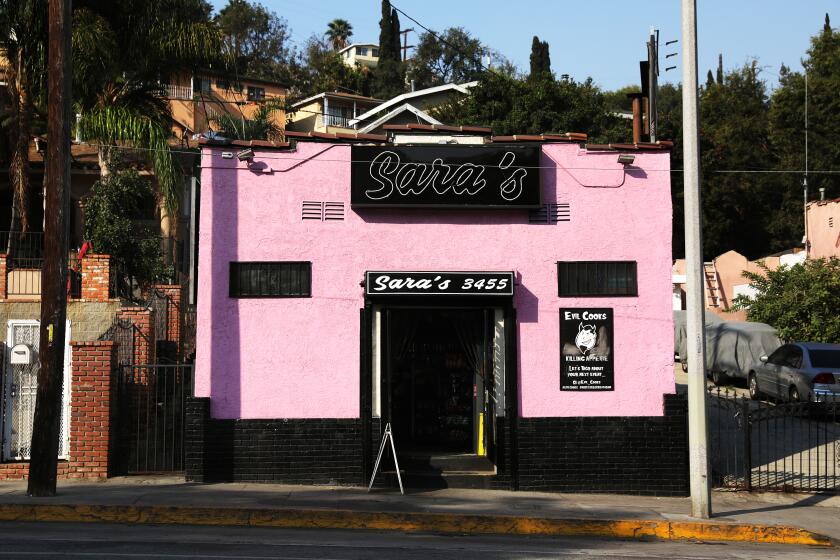Market Watch: Problems with farmers markets — and how to fix them
With concerns about cheating at farmers markets on the rise, the California Department of Food and Agriculture has scheduled four listening sessions around the state, including in Santa Monica on Monday, Nov. 1, to ask for public comment about its Certified Farmers Market Program, and especially to address concern about its integrity.
This step was prompted by two recent reports on NBC News that exposed several alleged market cheaters, peddlers who represented commercially bought produce as their own, or farmers who claimed that their produce had not been sprayed with pesticides, despite laboratory evidence to the contrary. Since the show aired, several farmers have been suspended by county authorities for cheating, and many market-goers have become suspicious they are being bilked.
Knowledgeable market observers believe that cheating has increased considerably over the last decade. There’s likely some peddled produce in almost every market; in many venues, half or more of the vendors appear to be cheaters — selling produce that is clearly out of season in their area, or unlikely to have been grown on their farms.
In a way, California certified farmers markets are a victim of their own success, since their numbers have roughly doubled over the last decade, to more than 700, while the numbers of authentic farmers to meet this demand — and of agricultural inspectors to enforce market regulations — have not increased proportionally.
Farmers market customers are willing to pay top dollar for produce they believe to be local, fresh, organic or not sprayed with pesticides. Industrially grown produce, raised with industrial efficiencies of scale, is comparatively cheap, tempting vendors to buy from neighbors, packinghouses and wholesale sources on the sly. This violates state farmers market rules, but allows them to obtain a profitable, more consistent supply.
County and state inspectors (along with managers) are responsible for enforcing market rules against cheating, but they have limited personnel and resources. Some county agricultural authorities view peddling as a victimless violation and rarely fine or suspend from markets local farmers, with whom they may be friendly.
But cheating is not a victimless violation. Customers are defrauded, duped into paying high prices for commercial-grade produce. Honest growers often can’t compete with cheaters and withdraw from markets. The core attraction of farmers markets — real farmers selling directly to consumers — is in danger of slipping away.
To retain public confidence, farmers and managers have proposed many ideas, including these, as the first, most urgent steps to address this concern:
1) Because farmers usually grow and sell in multiple counties, California Department of Food and Agriculture enforcement officers with statewide authority are better able to catch cheaters than county inspectors on their own. At a minimum, the farmers market industry needs to fund two new CDFA officers — one each for Northern and Southern California — along with the associated administrative support and benefits.
2) Farmers pay a 60-cent stall fee each time they sell at a farmers market, which is the only source of funding for the CDFA farmers market program (which had a budget of $221,000 in the 2010-11 fiscal year, according to Steve Lyle, a spokesman for the agency). That is not enough to pay for effective enforcement. In years past, the Certified Farmers Market Advisory Committee, composed chiefly of farmers and managers, suggested raising this fee, only to be discouraged by the CDFA, which did not want to be seen as increasing taxes on farmers, says Gene Etheridge, a Dinuba, Calif., grower who is the committee’s chairman. The California Legislature should pass a bill instructing the CDFA to write new regulations increasing the fee, which would probably not take effect until January 2012, when the current authorization for the state farmers market program is set to expire.
3) The CDFA should hire enforcement agents who know the crops, their seasons and their growing areas, as well as the ploys used by cheaters. They should conduct both random inspections and investigations based on tips and observations.
4) Each county should raise fees for certified producers’ certificates as needed to fund enforcement at the county level. Effective enforcement requires coordinated, timely inspections of farms and markets.
5) Farmers should be required to list which certified markets they sell at each quarter. (Pending regulations will achieve this, says CDFA’s Lyle). Records of sales from each market, called load sheets, should be readily available to investigators. Comparing sales to estimated production is an indispensable tool for catching cheaters. For this to work, certified producer certificates and load sheets must be filled out accurately and include individual varieties, in a uniform format.
6) CDFA should organize a systematic program to train managers. Educate them about integrity; encourage them to spot cheating, to cooperate and to exchange information.
7) Managers and inspectors (both state and county) should control bogus claims that produce is “organic” or “no spray.” Verify claims by correlating them with county records of pesticide use and by random laboratory tests. (The CDFA is “exploring a pilot program” to address this issue, Lyle says.)
8) CDFA should publicize state and county sanctions for substantial violations on its website, like letter grades for restaurants.
An effective integrity program would increase the quality but might decrease the quantity of produce available at farmers markets. In the short term, prices might well increase, and some markets might have to close. But in the long term, this would serve as an incentive to genuine farmers. Realistically, some cheaters will find new or more clever ways to circumvent market rules, so regulators and enforcers will need to stay nimble.
The measures listed above are relatively noncontroversial steps that can be implemented in the short to medium term. For the longer term, those who care about farmers markets must address wider questions about their identity and focus. What purpose do they serve? Who should benefit? What products should they sell?
There are other longer-term and almost certainly more controversial ideas proposed by farmers and managers to address these concerns. All require debate and scrutiny to make sure their benefits substantially outweigh their drawbacks:
1) Apply stricter controls over the finances of nonprofit organizations that sponsor markets, to make sure that these organizations’ primary purpose is to serve the public, not to make money for the owners.
2) Require that certified produce account for a majority of vendors and sales at each certified farmers market, not prepared foods and crafts. The latter are more profitable, but when they become the focus of a market, the certified produce section can become a neglected stepchild.
3) Forbid the sale of noncertified produce and related items in the “nonagricultural” sections of certified farmers markets. This should include, but not be limited to, those items that compete with California produce (for example, Washington apples, Chinese mushrooms, dried pineapple, Greek olive oil).
4) Require certificate holders who lease farm properties to be involved in the majority of agricultural practices, so that they cannot just come along at harvest to pick up another farmer’s crop.
The CDFA listening sessions will be held Oct. 27 in Sacramento (1220 N St., 12:30 – 3 p.m.); Nov. 1 in Santa Monica (Main Public Library, 601 Santa Monica Blvd., 5:30 – 7:30 p.m.); Nov. 3 in Fresno (2600 Fresno St., 5:30 – 7:30 p.m.); and Nov. 8 in Berkeley (2134 Martin Luther King Jr. Blvd., 5:30 – 7:30 p.m.).
More to Read
Eat your way across L.A.
Get our weekly Tasting Notes newsletter for reviews, news and more.
You may occasionally receive promotional content from the Los Angeles Times.










